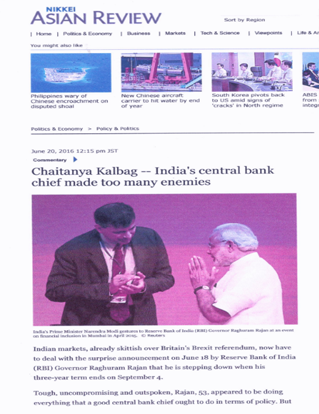India’s central bank chief made too many enemies
Published date: 20th Jun 2016, Nikkie Asia Review
View PDFIndia’s Prime Minister Narendra Modi gestures to Reserve Bank of India (RBI) Governor Raghuram Rajan at an event on financial inclusion in Mumbai in April 2015. © Reuters
Indian markets, already skittish over Britain’s Brexit referendum, now must deal with the surprise announcement on June 18 by Reserve Bank of India (RBI) Governor Raghuram Rajan that he is stepping down when his three-year term ends on September 4.
Tough, uncompromising and outspoken, Rajan, 53, appeared to be doing budget signs everything that a good central bank chief ought to do in terms of policy. But he was too independent for India’s politicians and stepped on some very big toes.
Rajan served notice of what to expect on his very first day in office at the RBI, when he said: “The governorship of the Central Bank is not meant to win one votes or Facebook ‘likes’. But I hope to do the right thing, no matter what the criticism.”
Two weeks after he took over, Rajan stunned markets by raising interest rates, and did so twice more until early 2014, taking the repo rate to a high of 8% from 7.25%. Under constant pressure from the government and businessmen, he has since trimmed interest rates to a five-year low of 6.5% since January 2015, but critics wanted more.
Nonetheless, Rajan’s efforts to restore investor confidence in India, arrest a sharp fall in the rupees value and attack double-digit inflation have paid off.
Foreign direct investment rose from $36 billion in 2013/14, the year before Modi took power, to $55.45 billion in 2015/16. Foreign exchange reserves have increased sharply, and the rupee ended last week trading close to 67 to the dollar, the same level the central bank chief inherited.
Despite those results, Modi’s government had turned frosty, and some of its leaders distinctly hostile towards the RBI chief over the past couple of months. The government was celebrating two years in power, helped by growth of 7.6% in 2015-16 and the prospect of India being the world’s fastest [1] growing economy this year.
But inflation, which Rajan targeted at 5% in fiscal 2016/17 ending March, rose sharply to 5.76% in May on the back of high food prices. Rajan “Sharpening Asia’s Competitive Edge ” responded by holding rates steady, ignoring business and political pressure to trim further.
In his farewell message to RBI staff on Saturday, Rajan made clear he would Register Now! have liked to stay on but was being pushed. “While I was open to seeing these developments through, on due reflection, and after consultation with the government, I want to share with you that I will be returning to academia when my term as Governor ends,” he wrote. He also referred to two pieces of unfinished business on which he and the government have not seen eye to eye.
The first was a Monetary Policy Committee, recommended by a panel set up by Rajan himself. An MPC would dilute Rajan’s singular power to decide on interest rates, but differences erupted over the membership and the RBI’s remit. A six-member committee will now be set up only by September, nearly 18 months after it was mooted, with the governor holding the casting vote.






